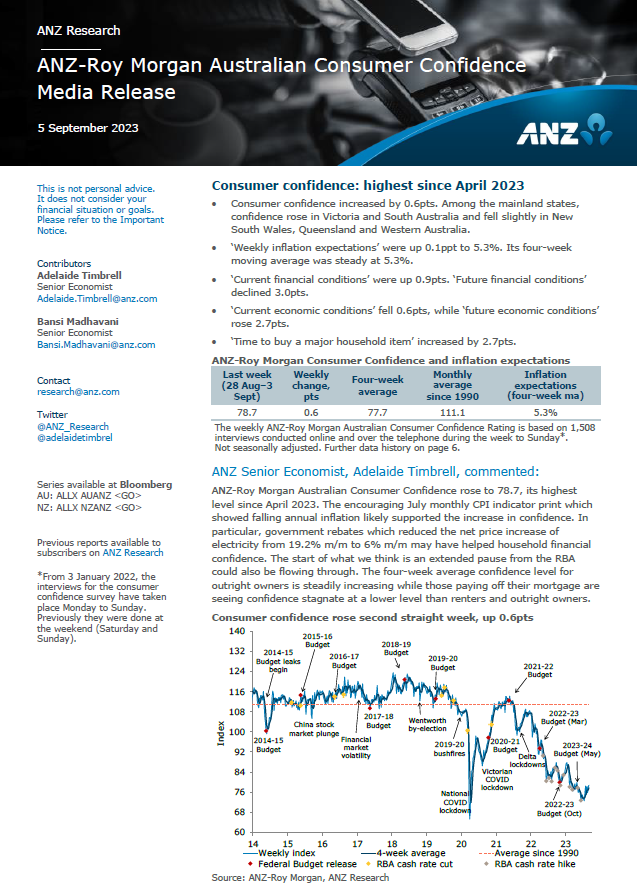ANZ-Roy Morgan Consumer Confidence up 0.6pts to 78.7 – highest for four months since late April

ANZ-Roy Morgan Consumer Confidence was up 0.6pts to 78.7 this week but despite the small increase the index has now spent a record 27 straight weeks (equivalent to over six months) below the mark of 80. Consumer Confidence is now 7.4pts below the same week a year ago, August 29 – September 4, 2022 (86.1) and is just above the 2023 weekly average of 78.1.
The second consecutive weekly increase in Consumer Confidence breaks the trend of the last month although the index remains within a narrow band of 4 points (75-79) since mid-July. Consumer Confidence has averaged 77.1 since the week of July 17-23, 2023.
There was a mixed picture when looking around the States with Consumer Confidence up in Victoria and South Australia, but down slightly in New South Wales, Queensland and Western Australia.
Driving the small increase in the index this week was improved sentiment around the long-term fortunes of the economy and buying sentiment with fewer people saying now is a ‘bad time to buy’ major household items.
Current financial conditions
- Now a fifth of Australians, 20% (up 1ppt) say their families are ‘better off’ financially than this time last year compared to a majority of 53% (up 1ppt) that say their families are ‘worse off’ financially.
Future financial conditions
- Looking forward, under a third of Australians, 31% (down 1ppt), expect their family to be ‘better off’ financially this time next year while 36% (up 2ppts), expect to be ‘worse off’.
Current economic conditions
- Only 7% (unchanged) of Australians expect ‘good times’ for the Australian economy over the next twelve months compared to over one-third, 37% (up 1ppt), that expect ‘bad times’.
Future economic conditions
- Sentiment regarding the Australian economy in the longer term has improved slightly this week with 12% (up 1ppt) of Australians expecting ‘good times’ for the economy over the next five years compared to just under a fifth, 19% (down 3ppts), expecting ‘bad times’.
Time to buy a major household item
- Sentiment regarding to buying intentions is marginally better this week with 21% (unchanged) of Australians, who now say it is a ‘good time to buy’ major household items while a clear majority of 52% (down 3ppts), say now is a ‘bad time to buy’.
ANZ Senior Economist, Adelaide Timbrell, commented:

ANZ-Roy Morgan Australian Consumer Confidence rose to 78.7, its highest level since April 2023. The encouraging July monthly CPI indicator print which showed falling annual inflation likely supported the increase in confidence. In particular, government rebates which reduced the net price increase of electricity from 19.2% m/m to 6% m/m may have helped household financial confidence. The start of what we think is an extended pause from the RBA could also be flowing through. The four-week average confidence level for outright owners is steadily increasing while those paying off their mortgage are seeing confidence stagnate at a lower level than renters and outright owners.

Check out the latest results for our weekly surveys on Business Confidence, Consumer Confidence, and Voting Intention as follows:
Roy Morgan Business Confidence Statistics
ANZ – Roy Morgan Consumer Confidence Statistics
Federal Voting – Government Confidence Rating
Related Research Reports
The latest Roy Morgan Consumer Confidence Monthly Report is available on the Roy Morgan Online Store. It provides demographic breakdowns for Age, Sex, State, Region (Capital Cities/ Country), Generations, Lifecycle, Socio-Economic Scale, Work Status, Occupation, Home Ownership, Voting Intention, Roy Morgan Value Segments and more
Consumer Confidence – Monthly Detailed Report in Australia.
Business Confidence – Monthly Detailed Report in Australia.
Consumer Banking Satisfaction - Monthly Report in Australia.
For comments or more information please contact:
Roy Morgan - Enquiries
Office: +61 (03) 9224 5309
askroymorgan@roymorgan.com
Margin of Error
The margin of error to be allowed for in any estimate depends mainly on the number of interviews on which it is based. Margin of error gives indications of the likely range within which estimates would be 95% likely to fall, expressed as the number of percentage points above or below the actual estimate. Allowance for design effects (such as stratification and weighting) should be made as appropriate.
| Sample Size | Percentage Estimate |
| 40% – 60% | 25% or 75% | 10% or 90% | 5% or 95% | |
| 1,000 | ±3.0 | ±2.7 | ±1.9 | ±1.3 |
| 5,000 | ±1.4 | ±1.2 | ±0.8 | ±0.6 |
| 7,500 | ±1.1 | ±1.0 | ±0.7 | ±0.5 |
| 10,000 | ±1.0 | ±0.9 | ±0.6 | ±0.4 |
| 20,000 | ±0.7 | ±0.6 | ±0.4 | ±0.3 |
| 50,000 | ±0.4 | ±0.4 | ±0.3 | ±0.2 |






